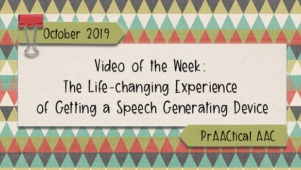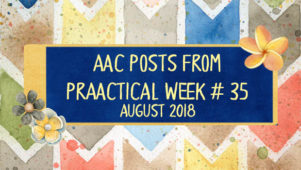PrAACtical Ideas for Repurposing Older AAC Technology

If you’ve been working in this field for awhile, chances are you’ve got some older voice output technology lying around. Poke around in the back of a closet or tucked way on top of the cupboards and you might encounter some hidden treasures.
If you look w-a-a-a-y back there, you just might find a few digitized (recorded) speech devices that haven’t been used for some time. With only 2, 4, 8, 9, or 32 locations, these are generally insufficient for individuals with complex communication needs to use as their personal communication devices.
When matched to the right purpose, though, these are wonderful tools that often have a lot of life left in them. How can we put those low tech AAC devices to work? Here are a few ideas to get us started.
- Build letter-sound knowledge: Program each cell with the sound of each letter so that the AAC student can play around with them. They’re also useful in classroom activities that require this type of response (e.g., “What sound does this letter make?”).
- Work on rhyming: Record rhyming words that allow them to participate in tasks and activities focusing on this skill. Most children can play with sounds and sub-vocalize to ‘test out’ their answers before responding. For children with AAC needs, we may want to compensate for this using technology.
- Animal and vehicle sounds: Seriously, shouldn’t every child have the chance to ‘moo’ or ‘vrooom’? Don’t rule out obnoxious noises, either. (Don’t we all know a middle schooler who is intensely motivated by burp and fart sounds?) Kids get to be kids.
- Special greetings: These could be of the ‘see-ya-later-alligator’ ilk or sayings specific to a time or event (e.g., Merry Christmas; Happy New Year). This would be great for teachers who ask their students how they want to say hello/goodbye (see this example) when they enter and leave for the day.
- Circle Time/Morning Meeting Routines: Predictable language, songs, and chants (like this one) are common in circle time and morning meetings. Consider programming some of that into a low tech SGD so that all students can participate.
Of course, any or all of these could well earn a place in a specific individual’s personal AAC device. That’s for the team to decide. For those who elect not to include these things in the person’s SGD, repurposed low tech SGDs may provide another option.
So, it’s time to clean out those closets, organize those cupboards, and dust off those shelves. If you do find a low tech SGD and decide to repurpose it, come back and tell us. We’d love to hear about it.
Filed under: Featured Posts, PrAACtical Thinking
Tagged With: low tech, SGD, SGD
This post was written by Carole Zangari




